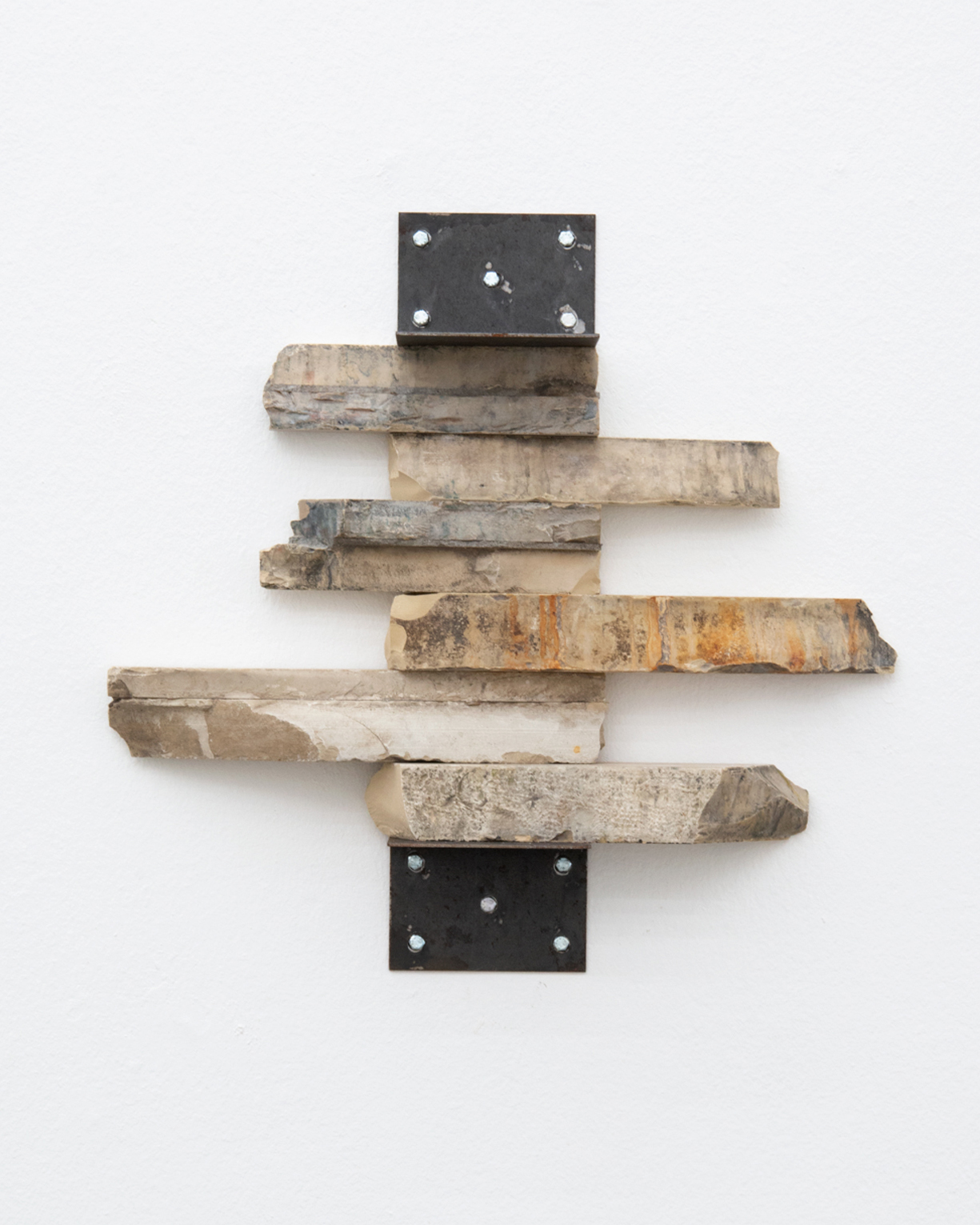Roma
litographic stones and iron
[pedra litográfica e ferro]
58 x 61 cm
2018

The construction of these body of works begins with a simple operation, the stacking. In it, rocks are held only by pressure at their ends. Lined up on the wall, they form a column that stands upright in an apparent fragile tone. The stones are moved to the sides and the “column” remains even more evident in a dialogue with the body, tensioning architecture and organic body in the same object. The name of important civilizations of antiquity such as Rome, Babylon and Egypt proposes a knowledge written and forged in stone, a wisdom carved in minerals that defy time and its ruins, as the works present themselves as small civilizational ruins as well.
Derived from accidents with lithographic stones that prevented them from exercising their original function - replicating the recorded images by multiplying the message contained on their surface - these lithographic refuse reorganize themselves in a mention of such societies, sometimes as the structuring column of the civilizing process, sometimes like the body that built and destroyed that same culture and prays like a library written in soft stone and that insists on continuing to resist.
Derived from accidents with lithographic stones that prevented them from exercising their original function - replicating the recorded images by multiplying the message contained on their surface - these lithographic refuse reorganize themselves in a mention of such societies, sometimes as the structuring column of the civilizing process, sometimes like the body that built and destroyed that same culture and prays like a library written in soft stone and that insists on continuing to resist.

Babilônia
litographic stones and iron
[pedra litográfica e ferro]
66 x 61 cm
2018

Egito
litographic stones and iron
[pedra litográfica e ferro]
71,5 x 40 cm
2018

Bizâncio
litographic stones and iron
[pedra litográfica e ferro]
58 x 61 cm
2018
photos Edouard Fraipont]
A construção deste corpo de obras parte de uma operação simples, o empilhamento. Nela, as rochas são presas somente pela pressão em suas extremidades. Alinhadas na parede elas formam uma coluna que se mantém em pé num aparente tom de fragilidade. As pedras são deslocadas para os lados e a “coluna” se mantém ainda mais evidente num diálogo com o corpo, tensionando arquitetura e corpo orgânico num mesmo objeto. O nome de importantes civilizações da antiguidade como Roma, Babilônia e Egito propõe um conhecimento escrito e forjado na pedra, uma sabedoria talhada em minerais que desafiam o tempo e suas ruínas, pois as obras se apresentam como pequenas ruínas civilizatórias também.
Derivadas de acidentes com pedras litográficas que as impediram de exercer sua função original - de replicar as imagens gravadas multiplicando a mensagem contida em sua superfície - esses refugos líticos reorganizam-se numa menção a tais sociedades, ora como a coluna estruturante do processo civilizatório, ora como o corpo que construiu e destruiu aquela mesma cultura e ora como uma biblioteca escrita em pedra mole e que insiste em continuar resistindo.
Derivadas de acidentes com pedras litográficas que as impediram de exercer sua função original - de replicar as imagens gravadas multiplicando a mensagem contida em sua superfície - esses refugos líticos reorganizam-se numa menção a tais sociedades, ora como a coluna estruturante do processo civilizatório, ora como o corpo que construiu e destruiu aquela mesma cultura e ora como uma biblioteca escrita em pedra mole e que insiste em continuar resistindo.





installation view at Galeria Vermelho, 2018
vista da instalação na Galeria Vermelho, 2018.